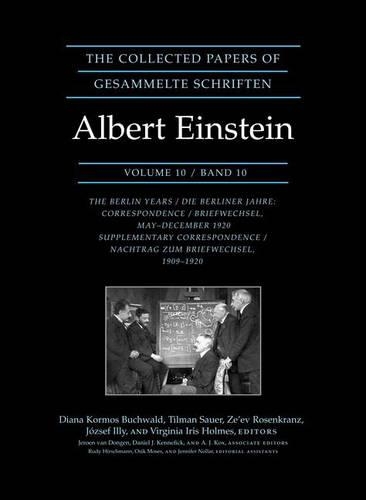
The Collected Papers of Albert Einstein, Volume 10: The Berlin Years: Correspondence, May-December 1920, and Supplementary Correspondence, 1909-1920 - Documentary Edition
(Hardback, Documentary Edition)
Available Formats
Publishing Details
The Collected Papers of Albert Einstein, Volume 10: The Berlin Years: Correspondence, May-December 1920, and Supplementary Correspondence, 1909-1920 - Documentary Edition
By (Author) Albert Einstein
Edited by Diana Kormos Buchwald
Edited by Tilman Sauer
Edited by Professor Zeev Rosenkranz
Edited by Jzsef Illy
Edited by Virginia Iris Holmes
Princeton University Press
Princeton University Press
10th October 2006
Documentary Edition
United States
Classifications
Professional and Scholarly
Non Fiction
Physics
Reference works
530
Physical Properties
Hardback
768
Width 191mm, Height 254mm
1616g
Description
The first half of this volume presents a substantial amount of heretofore unavailable correspondence. From among family letters closed for twenty years after the death of Margot Einstein, who donated them to the Albert Einstein Archives in Jerusalem, the volume presents, for the first time, letters written by Einstein's sons, the adolescent Hans Albert and little Eduard, and numerous letters written by Einstein to his cousin and future second wife Elsa Einstein. Combined with newly available correspondence with his close friend Heinrich Zangger, this supplementary correspondence provides vivid and intimate details of Einstein's private life. It documents the emotional bonds to his family and friends; the severe deprivations caused by the war to family members in Berlin and Zurich; the fragile health of Mileva Einstein-Maric during these years of separation and divorce; the worries and joys of caring for the sons; and Einstein's views on German and international politics during this turbulent period. The second half finds Einstein full of optimism about Germany's new democracy. He vigorously promotes general relativity and the endeavors of other scientists toward its further confirmation. He responds to the rising interest in his work among philosophers, as attested by correspondence with M. Schlick, H. Reichenbach, R. Carnap, E. Cassirer, and H. Vaihinger. And yet he is embroiled in vociferous, politically tinged, public attacks on his theory of relativity. He considers leaving Berlin, which would have deprived the Weimar Republic of its most famous scientist. In many letters, colleagues, friends, and unknown admirers offer support. Einstein travels to Leyden, where he is appointed a visiting professor and where, in the circle of friends such as P. Ehrenfest, H. A. Lorentz, and H. Kamerlingh Onnes, he is involved in lively debates on issues related to quantum physics. He visits Oslo and Copenhagen, where he meets with N. Bohr, and receives invitations to the United States, anticipating his first visit to the New World in 1921. ENGLISH TRANSLATION: A translation of selected non-English texts included in Volume 10 is available in paperback, http://www.pupress.princeton.edu/titles/8332.html. Since this supplementary paperback includes only select portions of Volume 10, it is not recommended for purchase without the main volume.
Reviews
"Like its predecessors, Volume 10, with its carefully edited and annotated texts, is a valuable source of information for historians. Together, its two parts provide new material for an appraisal of Einstein's familial and affective situation and offer vivid insight into one of the most intense periods of his life. Even if the content of some of these documents has been reported or hinted at elsewhere, their juxtaposition in a single volume reinforces their impact and helps to convey a sense of the scientific, philosophical, political, and social intensity of the times."--Jan Lacki, Isis
Author Bio
At the California Institute of Technology, Diana Kormos Buchwald is Professor of History; Tilman Sauer is a Senior Research Associate in History; and Ze'ev Rosenkranz, Jozsef Illy, and Virginia Iris Holmes are research staff in History.
